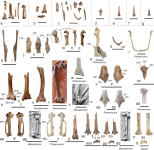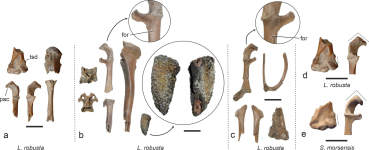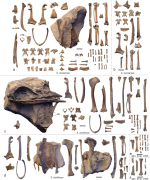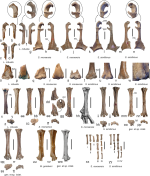Fred Ruhe
Well-known member

Gerald Mayr & Andrew C. Kitchene, 2024
The Picocoraciades (hoopoes, rollers, woodpeckers, and allies) from the early Eocene London Clay of Walton‑on‑the‑Naze
PalZ.
doi:10.1007/s12542-024-00687-9.
Abstract: The Picocoraciades (hoopoes, rollers, woodpeckers, and allies) from the early Eocene London Clay of Walton-on-the-Naze - PalZ
We describe upupiform, coraciiform, and possible piciform birds from the early Eocene London Clay of Walton-on-the-Naze (Essex, UK). The material includes partial skeletons of a new species of a small upupiform bird, Waltonirrisor tendringensis, gen. et sp. nov., which is the earliest known representative of the Upupiformes. Three very similar species of stem group rollers are assigned to Laputavis robusta, Septencoracias morsensis, and S. simillimus, sp. nov. These species only differ in minor features, which raises the possibility that the taxon Sepencoracias Bourdon, 2016 is a junior synonym of Laputavis Dyke, 2001. A smaller stem group roller from Walton-on-the-Naze resembles the North American primobucconid species Primobucco mcgrewi. We also describe two species of a new genus-level taxon, Pristineanis, gen. nov., which shows close affinities to the North American “Neanis” kistneri and may be a stem group representative of the Piciformes. In many aspects of their postcranial osteology, the stem group Coracii from Walton-on-the-Naze, as well as the new taxon Pristineanis, resemble coeval Trogoniformes from this fossil site. Because trogons are the extant sister taxon of the Picocoraciades – the clade including the Upupiformes, Coraciiformes, and Piciformes –, the shared similarities are likely to be plesiomorphic for this latter clade. Early Cenozoic representatives of the Upupiformes and Coraciiformes were much smaller than their extant relatives, which suggests that the Picocoraciades are an avian example of Cope’s Rule that postulates a tendency for size increase in evolutionary lineages over time.
P. S,
The new species of Pristineanis, gen. nov. are:
Pristineanis minor, sp. nov. and Pristineanis major, sp. nov.
Enjoy,
Fred
The Picocoraciades (hoopoes, rollers, woodpeckers, and allies) from the early Eocene London Clay of Walton‑on‑the‑Naze
PalZ.
doi:10.1007/s12542-024-00687-9.
Abstract: The Picocoraciades (hoopoes, rollers, woodpeckers, and allies) from the early Eocene London Clay of Walton-on-the-Naze - PalZ
We describe upupiform, coraciiform, and possible piciform birds from the early Eocene London Clay of Walton-on-the-Naze (Essex, UK). The material includes partial skeletons of a new species of a small upupiform bird, Waltonirrisor tendringensis, gen. et sp. nov., which is the earliest known representative of the Upupiformes. Three very similar species of stem group rollers are assigned to Laputavis robusta, Septencoracias morsensis, and S. simillimus, sp. nov. These species only differ in minor features, which raises the possibility that the taxon Sepencoracias Bourdon, 2016 is a junior synonym of Laputavis Dyke, 2001. A smaller stem group roller from Walton-on-the-Naze resembles the North American primobucconid species Primobucco mcgrewi. We also describe two species of a new genus-level taxon, Pristineanis, gen. nov., which shows close affinities to the North American “Neanis” kistneri and may be a stem group representative of the Piciformes. In many aspects of their postcranial osteology, the stem group Coracii from Walton-on-the-Naze, as well as the new taxon Pristineanis, resemble coeval Trogoniformes from this fossil site. Because trogons are the extant sister taxon of the Picocoraciades – the clade including the Upupiformes, Coraciiformes, and Piciformes –, the shared similarities are likely to be plesiomorphic for this latter clade. Early Cenozoic representatives of the Upupiformes and Coraciiformes were much smaller than their extant relatives, which suggests that the Picocoraciades are an avian example of Cope’s Rule that postulates a tendency for size increase in evolutionary lineages over time.
P. S,
The new species of Pristineanis, gen. nov. are:
Pristineanis minor, sp. nov. and Pristineanis major, sp. nov.
Enjoy,
Fred
Last edited:







